By Pam Brown
As residents of Florida, we enjoy wonderful weather almost year-round. But our moderate winter weather and the hot, wet, humid summers conspire to support many insect, bacterial and fungal pests that can damage our landscapes and our homes. There are many pesticides on the market that promise to help rid us of these pests if we will just use them. However, it is unreasonable to expect a pest-free environment in Florida.
I don’t know about you, but I’m increasingly concerned about all of the chemicals used to control pests. Pesticide residues can build up and sometimes persist for many years in the environment. In Tampa Bay, stormwater rushing across our landscapes has become a primary source of toxic contaminants to our beautiful aquatic ecosystems.
The “What’s on My Food” website lists 44 different pesticide residues found by the United States Department of Agriculture Pesticide Data Program in water and groundwater in 2008. I wonder how many there are now? I, for one, don’t subscribe to the notion of “better living through chemistry.” There are other alternatives that are much safer in nearly every circumstance.
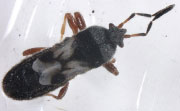
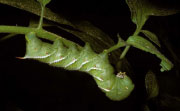
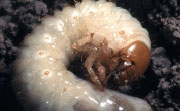
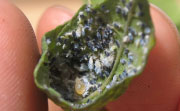
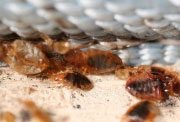

When looking for
alternatives to toxic pesticides, the first lines of defense are excluding pests from our homes and using proper cultural practices in the landscape. Inside the home, make sure that any cracks at the foundation or where pipes or wiring enter the house from outside are caulked, and windows and doors do not have visible gaps where insects might enter.
Keeping mulch and other debris away from the foundation will reduce moisture that can harbor insect pests that find their way indoors, as well as the dreaded termites that eat our homes from the inside out. The University of Florida Extension publication “The Facts about Termites and Mulch” states that mulch can contribute to the survival of established termites by keeping the soil moist and temperatures moderate. If mulch must be used next to the foundation, keep the layer less than two inches deep for a distance of 12 inches from the wall. This reduces the possibility that termites can move across the treated soil to get to the foundation. For more information from the University of Florida about structural pests and their control, visithttp://edis.ifas.ufl.edu/topic_household_and_structural_pests.
Proper cultural practice in the landscape starts with placing the right plant in the right place for the growing conditions, then caring for it appropriately with proper watering and fertilizer. A healthy plant is much more likely to survive an attack by harmful insects or disease. Diverse plantings also act as a foil for insect infestations.
It has been said that nature abhors a monoculture and large fields consisting of one agricultural crop that need pesticides to thrive are a perfect example. Closer to home, lawns are probably our largest monoculture. Eileen Buss, a researcher at the University of Florida, has reported that St. Augustine grass that is watered heavily and fertilized with large amounts of water-soluble nitrogen will have a greater number of chinch bug eggs laid and adults feeding than St. Augustine that has been watered moderately and fertilized with slow-release nitrogen. Many insects that attack plants prefer new succulent growth and too much water and fertilizer fuels new growth.
Before you pull out weedkiller, consider weed control. Pulling weeds before they become well-established could be the only control you need, especially important before they bloom and produce seeds. Many herbicides can damage your desirable plants and trees when used to kill weeds in planting beds or your lawn. I personally find pulling weeds, where I can be outside enjoying the fresh outdoors along with the birds and other wildlife, very pleasant. A natural pre-emergent weed control that also adds some slow-release nitrogen fertilizer is corn gluten meal.
But what do we do if our diligent attention still doesn’t keep damaging insects away from our landscapes? If you do see that you have an infestation of a pest insect or disease, you could start by removing the diseased or infested portions of the plants. Learn what beneficial insects, such as ladybugs, look like and look for their activity. Many times they are all the control that you need for insect pests, especially if you remove the infested plant parts.
If you still need to treat the problem, then consider a natural or organic product. The natural pesticides in my arsenal are neem oil, insecticidal soap, sulfur, copper, horticultural oil (Organocide), and a product containing the bacterium Bacillus thuringiensis (Bt) (Thuricide). I scout my landscape for pests weekly so I seldom need stronger pesticides if I catch infestations soon enough. Natural products for insect pest management are primarily either botanical, soap, mineral or biological.
Botanical insecticides include horticultural oils derived from plants such as sesame (Organocide is primarily sesame oil mixed with fish oil), citrus (d-limonene and linalool) and neem. A number of other botanicals are derived from various plant parts. Pyrethrum, derived from the flowers of a daisy-like plant, is the most widely used botanical insecticide in the U.S. Other botanicals include rotenone, ryania, and sabadilla, but the list of all the commercially available botanicals is quite long. In addition, recipes abound for creating your own insecticides from garlic, onion, chili peppers, baking soda, liquid soap and vegetable oil.
Oils can control pests by blocking the air or breathing holes of the insects, thus suffocating them. There is no residual activity with oils so the oil must coat the insect for it to be effective and repeat spraying is usually necessary.
Neem oil is derived from the seeds of the neem tree. It is not toxic to pets, wildlife or humans. In fact toothpaste, soap and skin creams are made from the oil or other parts of the tree. I recommend NimBioSys 100% cold-pressed neem oil that I order online from Brandon-based Neem Tree Farms. Most of the neem oil that is available commercially is only a 70% neem oil product. Neem oil is considered an insecticide, miticide (spider mites), and a fungicide (especially powdery mildew), so it has multiple functions.
Besides being oil that smothers insects, it primarily acts as a growth regulator and feeding deterrent for the insects feeding on a sprayed plant. I am sure that you have heard about the bed bug problems that are cropping up here in the US. Besides being a great pesticide for the landscape, cold-pressed neem oil was recently registered as a control for bed bugs with the US Environmental Protection Agency (EPA).
Oils from oranges and other citrus fruit peels are distilled to make d-limonene and linalool. Both of these compounds are insecticidal contact poisons or nerve toxins that are considered safe for use around humans and pets. Commercial products are usually called “d-Limonene.” The EPA has registered these products to use against fleas, aphids and mites. However, they also seem effective for fire ants, paper wasps, crickets and some flies.
A very concentrated proprietary orange oil product called XT2000 Orange Oil Plus is marketed to treat dry wood termites as a more environmentally safe alternative than whole-house tenting using toxic gas. With this method, which must be applied by a trained and certified pesticide operator, the orange oil is injected into the wood determined to have active dry wood termites where it kills them. This orange oil product is not used to treat for the subterranean termites most often found in the Tampa Bay region.
Insecticidal soaps are potassium salts of fatty acids. They are similar to common household soaps but have been specifically selected for their ability to kill insects. They seem to work by disrupting the cell membranes or by removing the protective wax covering of the insect so that it dies from water loss. There is no residual activity, so the insects must be covered by the spray for this product to work. Retreatment may be necessary, as often as weekly, if coverage isn’t complete. There can be phytotoxicity in some plants so test a small portion of the plant then watch for leaf burn before spraying the whole plant. These sprays are generally effective against most small, soft-bodied insects such as aphids, scales, mealybugs, whiteflies and spider mites.
Mineral pesticides include sulfur, copper, borax, baking soda and diatomaceous earth. Sulfur is one of the oldest pesticides around. It can be used as a dust or liquid, primarily for controlling diseases such as powdery mildew, rust and leaf blight But thrips, psyllids and mites can also be controlled. Sulfur cannot be used with other pesticides, especially horticultural oils. Serious damage to the plants can occur.
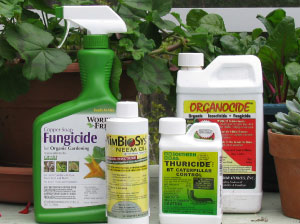
Some natural enemies can be purchased, but you will be most successful if the natural enemy is matched carefully to the pest needing control. For the homeowner, it is probably best to provide a healthy environment (no chemical pesticides) for the natural enemies, and they will come when there are pests to be controlled.
As more and more people become aware of the dangers of synthetic chemical pesticides, there is more information available on safer alternatives. Many people — even in Florida — have discovered that using natural products to combat pests is as effective as the chemicals. There is a lot of information out there, particularly on the University of Florida website, so do some additional research. You might find that once you begin to use more natural ways to combat pests, you have more beneficial insects and possibly more wildlife in your landscape to enjoy.
Pam Brown earned a master’s degree in ornamental horticulture from Virginia Tech. She served as the University of Florida Urban Horticulture Extension Agent in Pinellas County for eight years and currently serves as president of Pampered Gardeners.
[su_divider]
Originally published Spring 2013